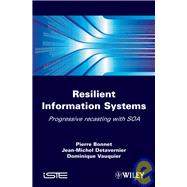
Note: Supplemental materials are not guaranteed with Rental or Used book purchases.
Purchase Benefits
What is included with this book?
Pierre Bonnet is the co-founder of Orchestra Networks, a software editor specialized in Model-driven MDM. He is also the founder of the "Sustainable IT Architecture" and "MDM Alliance Group" communities.
Foreword.
Preface.
Guide for the Reader.
Introduction to the SOA Project at SMABTP.
Chapter 1. Initial Perspectives.
1.1. 50 years of computing – an overview.
1.2. What remains today?
Part I. Why a Sustainable Information System?
Chapter 2. Company-oriented Services.
2.1. Consequences of the Internet revolution.
2.2. What do the leading market players say?
2.3. What do the chief information officers think?
2.4. The issues faced at general management level.
2.5. Levels of maturity.
Chapter 3. SOA Maturity Levels.
3.1. Towards the creation of a more agile information system.
3.2. Cosmetic SOA.
3.3. Extended SOA.
3.4. Overhaul SOA.
3.5. The matrices of SOA maturity.
Chapter 4. Economic and Social Aspects.
4.1. Removal of obstacles that may slow down the progressive overhaul of an information system.
4.2. The future of IT specialists..
4.3. Off-shoring.
4.4. The generation mix.
4.5. The role of software infrastructure editors.
Part II. The Principles of SOA.
Chapter 5. The Properties of SOA.
5.1. The definition of service for users.
5.2. The definition of service for IT specialists.
5.3. The properties of basic SOA.
5.4. The properties of agility.
Chapter 6. Orchestration (BPM and SOA).
6.1. Multiple requirements in orchestration.
6.2. The levels of orchestration.
6.3. The techniques of orchestration.
6.4. Towards the homogenization of orchestration.
6.5. The benefits of orchestration.
6Part III. The Need for an Enterprise Method.
Chapter 7. The Discovery of Services (Reference Framework and Urbanization).
7.1. New needs for the information system.
7.2. Why are different methods seldom used within companies?
7.3. Reference frameworks.
7.4. Essential tools.
Chapter 8. The Praxeme Enterprise Method.
8.1. Praxeme: the initiative behind a public method.
8.2. The Praxeme method.
8.3. Enterprise system topology according to the Praxeme method.
8.4. What the Praxeme method means for SOA.
8.5. Advantages of the Praxeme method.
Chapter 9. Modeling with Praxeme.
9.1. The modeling of requirements.
9.2. Semantic modeling.
9.3. Pragmatic modeling.
9.4. Pre-modeling.
9.5. Logical modeling.
9.6. Logical modeling of batch computing.
9.7. Technical modeling.
9.8. Software modeling.
9.9. Benefits of the methodology.
Part IV. Mastering Existing Techniques.
Chapter 10. Tools for Industrializing the Method.
10.1. Requirements in the industrialization of procedures.
10.2. Frameworks and design patterns.
10.3. Tools for increased agility.
10.4. Representation tools.
10.5. Tools for tests and management.
10.5.1. Non-regression tests.
10.6. Tools for the management of different versions and the configuration of programs.
10.7. Benefits of using tools in the method.
Chapter 11. Systems Integration and Common Information Language.
11.1. New requirements in communication.
11.2. ESB's functions.
11.3. Integrating ESB into SI.
11.4. ESB’s benefits.
Chapter 12. SOA Platform.
12.1. Requirements for the global vision of technical architecture.
12.2. New technical components.
12.3. Managing performance.
12.4. Managing exploitation.
12.5. Managing maintenance.
12.6. Benefits of SOA platforms.
Chapter 13. Rules Management at the Scale of the Whole Enterprise (Jérôme BOYER, ILOG Software).
13.1. Overview.
13.2. Deep view.
13.3. When to use a rule engine.
13.4. Logical architecture view.
13.5. BRMS and SOA.
Chapter 14. Semantic Integration (Erik STEINHOLTZ, Progress Software).
14.1. Enabling the adaptive enterprise.
14.2. Inhibitors for change.
14.3. Definition of semantic integration.
14.4. Parallel track information modeling.
14.5. Change inhibitors addressed with semantic integration.
14.6. Putting it to work.
Conclusion.
Weblinks.
Bibliography.
Special Technical Note.
Index.
The New copy of this book will include any supplemental materials advertised. Please check the title of the book to determine if it should include any access cards, study guides, lab manuals, CDs, etc.
The Used, Rental and eBook copies of this book are not guaranteed to include any supplemental materials. Typically, only the book itself is included. This is true even if the title states it includes any access cards, study guides, lab manuals, CDs, etc.